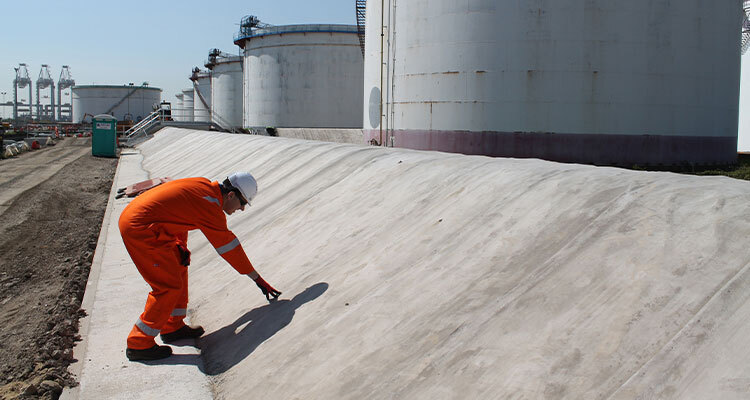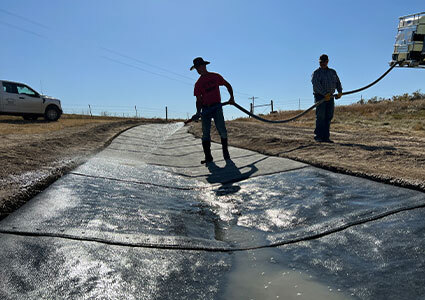
UK-based manufacturer, Concrete Canvas, changes the construction game with innovative, lower carbon materials
Less than 20 years ago, two friends at a university in London would take a chance on their shared vision for an advanced new concrete construction material. As Peter Brewin, Co-Director of Concrete Canvas, explains: “The company was set up by me and Will Crawford while we were students. The initial concept for Concrete Canvas was a construction company focussed entirely on concrete buildings. In order to make that work, we decided to invest in a new class of materials, and that soon became the focus of our business. The product is essentially concrete that can be stored on a roll. It’s installed much like a heavy carpet — you roll it out, spray it with water, and just like that you have a hard-wearing concrete surface. Our product makes it ten times faster to create a concrete surface, and with that we are using between 90 and 95 per cent less material. That means instead of taking dozens of concrete mixers onto site, you only need one flatbed lorry, and it will take you a fraction of the time.
 “Our concrete composite material is now used all over the world. We’ve helped complete projects in over 100 countries, and we have sales partners in 65 of those. While we have offices on every continent, all of our manufacturing is done in the UK.”
“Our concrete composite material is now used all over the world. We’ve helped complete projects in over 100 countries, and we have sales partners in 65 of those. While we have offices on every continent, all of our manufacturing is done in the UK.”
New product development
Remaining a UK-based manufacturer has had its ups and downs, but as Peter affirms, Concrete Canvas is up to the challenge: “The last few years have been extremely difficult for UK manufacturers. The energy market makes manufacturing here very expensive, and the way it’s structured isn’t geared toward manufacturers. We’re also facing skilled labour shortages, which has put pressure on the operation.
“Being a manufacturer in the UK is definitely hard going, but we’ve managed to make a success of it by being very innovative and investing heavily in long-term research and development. We also make it very clear how much we value our people, and have incentives set up for them to succeed,” he affirms.
Keeping operations in the UK has allowed founders Peter and Will to stay close to their product, even as the company has become a global operation. As Peter discusses: “Our standard product a construction composite called a Geosynthetic Cementitious Composite Mat (GCCM), has evolved a lot over time. It’s improved substantially since we first started, but it’s still based on the same core technology. We now have three types of GCCM available, known as CCT1 (Concrete Canvas Type 1 GCCM), CCT2 and CCT3. All of these products conform to ASTM D 8364 and can be used for Type 1, 2 or 3 erosion control applications, which helps engineers understand how to safely specify and use this particular class of material. Each type of GCCM can be used in slightly different ways, from erosion control lining to inflatable water tanks and lining water channels. A lot of our work is on major infrastructure projects in the petrochemical, mining, road and railway industries.
“Concrete Canvas invented GCCM’s, after five years’ manufacturing and supplying this new composite globally, we developed a really good understanding of the technological aspects of the material. We decided to develop a new type of GCCM from scratch, using the knowledge we had gained over the previous years. We asked ourselves some big questions: How would we develop the next product? What was the next big application? We concluded that, on a global scale, materials for clean water transport would be in high demand. The reason for this is if you look at global trends, climate change is obviously becoming a huge issue for all sorts of people across the world. There’s also been a big shift in urbanisation. We felt that in the future, there would need to be more infrastructure capable of moving clean water from one place to another, specifically into bigger agricultural areas that need water to grow crops, which in turn feeds a growing population.
“In response to these trends, and the problem we anticipated, we developed a new product: CCX. It took 12 years of research and development from the initial concept until we had developed and tested CCX and had the bespoke production lines working. We launched CCX launched just under a year ago. CCX is another kind of GCCM. It enables you to link channels, fight erosion and control the flow of water very quickly. But it also incorporates all of the technological developments we saw over the past decade, meaning we are confident it is among the best technical solutions for clean water transport.”
concept until we had developed and tested CCX and had the bespoke production lines working. We launched CCX launched just under a year ago. CCX is another kind of GCCM. It enables you to link channels, fight erosion and control the flow of water very quickly. But it also incorporates all of the technological developments we saw over the past decade, meaning we are confident it is among the best technical solutions for clean water transport.”
US expansion
The driving force behind much of Concrete Canvas’ innovation is a desire to create more sustainable options for its customer base. “There are huge sustainability benefits to our product. Firstly, it comes with much less embodied CO2. That’s primarily because we’re using a lot less cement and conventional concrete per square metre of coverage. Additionally, the quality of our product is very well controlled simply by the way the material works, so the whole system is very effective. The end product functions much more as a composite than expected for a concrete-based material. It’s very durable, and less is more, so we’re helping the planet that way too,” Peter enthuses.
As operations in the UK continue to thrive, Concrete Canvas sets its sights stateside. As Peter details: “We’ve recently expanded operations in America with our new subsidiary, Concrete Canvas USA. The US operations currently supply our material, and we’ve got representatives nationwide working in sales and production. We’ve also got direct employees working on developing the US market and providing technical support to our US partners.
“The company started with technological innovation. We spent 20 years developing our knowledge about this material: how you install it, how to correctly specify the components, and how to properly design applications. All of these things keep our product functional and durable in the long-term. A big part of what we offer is the assistance we provide engineers and contractors who are using the product. It’s not just selling a product; it’s actually helping to ensure the final structure works effectively. We put a lot of energy into research and development, and it’s important that we carry those values over as we expand our presence in America,” he concludes.